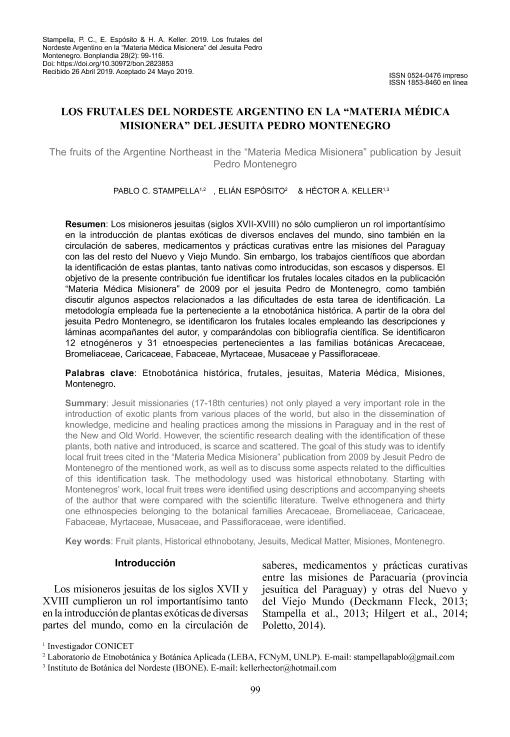Artículo
Los misioneros jesuitas (siglos XVII-XVIII) no sólo cumplieron un rol importantísimo en la introducción de plantas exóticas de diversos enclaves del mundo, sino también en la circulación de saberes, medicamentos y prácticas curativas entre las misiones del Paraguay con las del resto del Nuevo y Viejo Mundo. Sin embargo, los trabajos científicos que abordan la identificación de estas plantas, tanto nativas como introducidas, son escasos y dispersos. Elobjetivo de la presente contribución fue identificar los frutales locales citados en la publicación ?Materia Médica Misionera? de 2009 por el jesuita Pedro de Montenegro, como también discutir algunos aspectos relacionados a las dificultades de esta tarea de identificación. La metodología empleada fue la perteneciente a la etnobotánica histórica. A partir de la obra del jesuita Pedro Montenegro, se identificaron los frutales locales empleando las descripciones yláminas acompañantes del autor, y comparándolas con bibliografía científica. Se identificaron 12 etnogéneros y 31 etnoespecies pertenecientes a las familias botánicas Arecaceae, Bromeliaceae, Caricaceae, Fabaceae, Myrtaceae, Musaceae y Passifloraceae. Jesuit missionaries (17-18th centuries) not only played a very important role in the introduction of exotic plants from various places of the world, but also in the dissemination of knowledge, medicine and healing practices among the missions in Paraguay and in the rest of the New and Old World. However, the scientific research dealing with the identification of these plants, both native and introduced, is scarce and scattered. The goal of this study was to identify local fruit trees cited in the “Materia Medica Misionera” publication from 2009 by Jesuit Pedro de Montenegro of the mentioned work, as well as to discuss some aspects related to the difficulties of this identification task. The methodology used was historical ethnobotany. Starting with Montenegros’ work, local fruit trees were identified using descriptions and accompanying sheets of the author that were compared with the scientific literature. Twelve ethnogenera and thirty one ethnospecies belonging to the botanical families Arecaceae, Bromeliaceae, Caricaceae, Fabaceae, Myrtaceae, Musaceae, and Passifloraceae, were identified.
Los frutales del nordeste argentino en la “materia médica misionera” del Jesuita Pedro Montenegro
Título:
The fruits of the argentine northeast in the “materia medica misionera” publication by Jesuit Pedro Montenegro
Fecha de publicación:
07/2019
Editorial:
Instituto de Botanica del Nordeste
Revista:
Bonplandia
ISSN:
0524-0476
e-ISSN:
1853-8460
Idioma:
Español
Tipo de recurso:
Artículo publicado
Clasificación temática:
Resumen
Palabras clave:
FRUIT PLANTS
,
HISTORICAL ETHNOBOTANY
,
JESUITS
,
MEDICAL MATTER
,
MISIONES
,
MONTENEGRO
Archivos asociados
Licencia
Identificadores
Colecciones
Articulos(IBONE)
Articulos de INST.DE BOTANICA DEL NORDESTE (I)
Articulos de INST.DE BOTANICA DEL NORDESTE (I)
Citación
Stampella, Pablo César; Espósito Sandoval, Elián Maximiliano; Keller, Hector Alejandro; Los frutales del nordeste argentino en la “materia médica misionera” del Jesuita Pedro Montenegro; Instituto de Botanica del Nordeste; Bonplandia; 28; 2; 7-2019; 99-116
Compartir
Altmétricas




